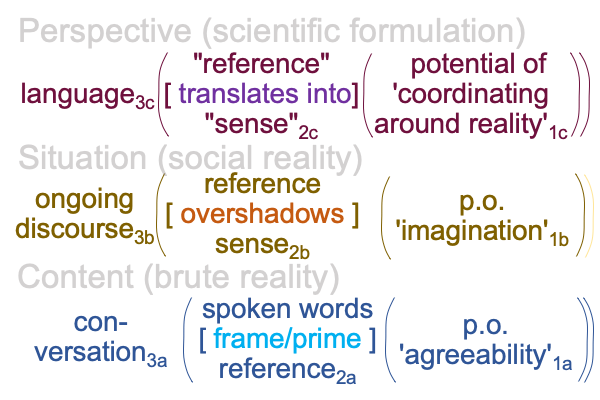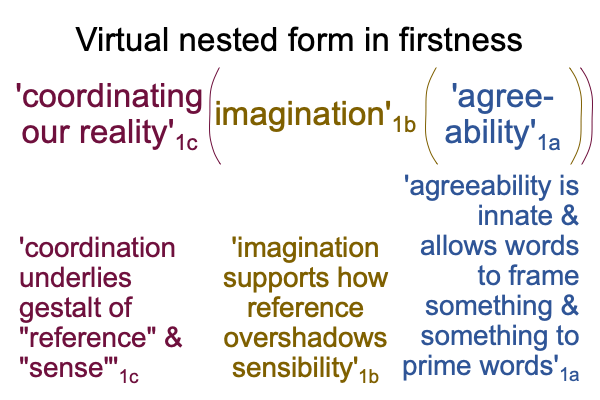1033 Chapter nine is titled, “Stories and What They Do To Us”.
Chapter ten is titled, “Social Glue”.
The sequence follows Professor Enfield’s argument. Chapter eight is examined. What comes next is a chapter on stories. Then, these stories are treated as social glue.
However, I have already touched the tar-baby of agreeability1a. So, the “tar” of agreeability1a must be dealt with before the “baby” of the story.
1034 Here is the current version of the ever-modulating intrinsic abstraction that I call, “Enfield’s interscope”.

1035 If conversation3a replaces the normal context of what is happening3a…
…and if purely symbolic spoken words2a replace the icons and indexes of hand talk2a…
…and if the potential of ‘agreeability’1a replaces the potential of ‘something happening’1a…
…then language and reality become our adversaries.
Or…
….maybe…
…we become their adversary, the “versus” standing between language and reality.
1036 In the Lebenswelt that we evolved in, hand talk is a valuable resource in team work and community coordination. Linguistic hand talk is not our enemy. It is a guide that opens new cognitive spaces (that today, corresponds to the meaning underlying the word, “religion”).
Language is our friend because… well… why would the talker lie to us?
Language is a key ingredient to “our social glue”.
We evolve by adapting to be agreeable1a.
Reality?
It is not so much a friend, but maybe, it is a companion.
1037 In our current Lebenswelt, speech-alone talk is a magical tool that creates realities that we never imagined, including the academic disciplines that Enfield discusses.
Yet, Enfield cannot fully and explicitly abstract the consequences of speech-alone talk. He cannot tell us that we are the “versus” in the title. This explains why he offers stories and story-telling as key ingredients to the human social glue. This accounts for why he cannot recognize that Wittgenstein’s rule is as impossible as levitation.
We are not built for Wittgenstein’s rule. We are designed to be agreeable1a.
1038 Indeed, a close reading of chapter ten shows that Enfield concurs, even though he does not draw the conclusion explicitly.
1039 Here is a diagram of the virtual nested form in the realm of possibility for Enfield’s interscope.

The normal context of coordinating our reality1c virtually brings the actuality of human imagination1b into relation with the potential of agreeablity1a.
